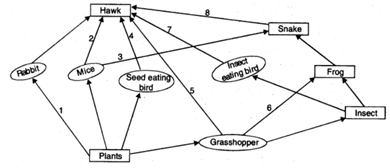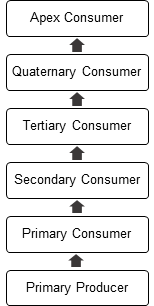IELTS Academic Writing Task 1 Sample 5
The Food Chain
Diagram 1 shows a food web containing eight food chains that are marked numerically, i.e. each number indicates a food chain involving the primary producer up to the apex consumer. Refer to Diagram 2 for the categories of consumers in a food chain presented hierarchically. Describe the food web through these links, drawing examples from your natural environment, in at least 150 words.
Use the following additional information if necessary:
Primary producers (plants) occupy the bottom level in a food chain/food web;
Apex consumers (hawk in Diagram 1) occupy the top level.
Diagram - 1

Diagram - 2

-
Sample Answer |
|---|
Our natural environment comprises several ecosystems, and food chains are crucial to sustain them. Diagram 1 depicts a food web with eight small food chains found very close to human habitation. The hawk is at the top of the web as an apex consumer while the plants, primary producers, are at the bottom. In the first chain, the plants are eaten by the rabbits who are hunted by the hawk. Likewise, there are mice and seed-eating birds that are dependent on plants for survival and are consumed by the hawk, shown in the second and fourth chain. The mice also contribute to the third food chain where they are eaten by the snakes as secondary consumers, who in turn become a meal for the hawk at the apex. In the fifth, sixth, seventh and the eighth chain, the grass hopper is at the primary consumer level. It is directly fed by the hawk in the fifth food chain. In the sixth, the frog as secondary consumer feeds on it, followed by the snake at the tertiary level and the chain thereafter ends with the hawk. The grasshopper is eaten by other insects in the seventh chain. These insects are consumed at the tertiary level by insect-eating birds that sustain the hawk. The eighth food chain has the highest number of links and includes all the hierarchical consumers listed in Diagram 2. It bifurcates from the level of the insects as secondary consumers, and has the frog as the tertiary, the snake as the quaternary and finally the hawk as the apex consumer. The food web reveals how damaging a single link can result in widespread imbalance in nature. |
-
Analysis |
|---|
COHERENCE AND COHESION
|
GRAMMAR
|
LEXICAL RESOURCE habitation - the state of living, or the place occupied by (in this context) humans. comprises - meaning ‘is composed/made (up) of’. Sometimes wrongly used with the preposition ‘of’ (i.e. ‘comprises of’), thought to be a misunderstanding drawn from ‘comprised of’. bifurcate(s) - divides or splits in two. Excellent word choice. can result in - a more concise way to make this point in the closing sentence would be ‘can cause’. Another alternative could be ‘can lead to’. |